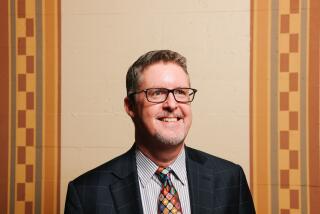Definitely not inkjet
- Share via
Stepping into the International Printing Museum in Carson feels a bit like taking a chance on a mystery gift in plain wrap. For inside the unassuming building, practically hidden in an industrial mall across from a Kmart, is a collection of antique printing presses that even the Smithsonian is said to envy.
The museum has one of the largest private collections of antique printing presses in the world, says Mark Barbour, director of the museum established in 1988. The 150 major pieces and thousands of small ones are from the personal collection of Ernest A. Lindner, a Los Angeles printing equipment dealer who spent 50 years wandering the world trying to preserve 19th and early 20th century presses. (Lindner, who died last year, often acquired equipment in trade.)
The treasures quickly reveal themselves on the crowded museum floor during a 60-minute tour that spans more than 500 years of history. Leading the way is our enthusiastic tour guide, Phil Soinsky, who also portrays Ben Franklin in shows at the museum. Soinsky is acting more like a game-show host, spewing out printing trivia and firing questions at his seven-person audience.
“What do you think of when you think of Ben Franklin?” he asks. People respond: printer, prolific inventor, publisher. “The $100 bill,” my daughter says. (She is 14.)
The tour begins in “Ben Franklin’s working Colonial print shop,” with a press from 1806, the third-oldest American-made printing press in existence. It quickly segues to a re-creation of a Gutenberg press from 1440 on which “Master Adam,” a boy on the tour tapped to be an apprentice, helps print the parables of Solomon on paper glowing with preprinted illuminated text.
“The biggest deal to people is that they see the machines working,” Soinsky says later. “In some museums, it’s like, ‘Don’t touch, just observe.’ ”
Our guide fashions type out of hot metal, then delivers a speedy English-language history lesson that touches on the origin of the expression “out of sorts.” (When printers ran out of sorted letters, they were not able to finish their work.)
Adam’s younger sister, who looks about 3, is mildly out of sorts and wants to leave halfway through. The museum, which gives tours to as many as 20,000 schoolchildren a year, recommends children be in at least fifth grade, but Soinsky says some “sharp cookies” in third grade have done just fine.
Like many of the presses, a show-stopping ornate machine from 1824 is used to frame a larger story. A tale of Early American marketing prowess is told through the Columbian Press, which dripped with American symbols and failed here, yet became a sensation in Europe.
When one press, built by a minister in 1870 who couldn’t afford to buy one, is set in motion, the group is asked to guess what it resembles (a grasshopper). But when Soinsky sits to work a Linotype machine from the same era, the keys just sputter.
Soinsky shrugs. In the “outside world” there was a mechanic to troubleshoot for every six Linotypes, he says. Today, one “actor-writer-cartoonist” keeps the show going before ending the tour in a back room, where groups (by appointment) reenact the Constitutional Convention.
*
International Printing Museum
Where: 315 Torrance Blvd., Carson.
Hours: Saturdays from 10 a.m. to 4 p.m. or by appointment. Second Saturday of the month usually features a craft activity.
Cost: $6.
Contact: (714) 529-1832 or www.printmuseum.org.
More to Read
Sign up for The Wild
We’ll help you find the best places to hike, bike and run, as well as the perfect silent spots for meditation and yoga.
You may occasionally receive promotional content from the Los Angeles Times.







